Lettuce is very easy to grow, takes up very little space, and you can also grow it in between flowers. Lettuce grows for several weeks in the mild spring and autumn seasons. Leaf Lettuce is easy to tuck between and under taller vegetables and is perfect for containers. Lettuce contains four major categories: Head Lettuce, Romaine, Leaf Lettuce, and Butterhead (loosehead).
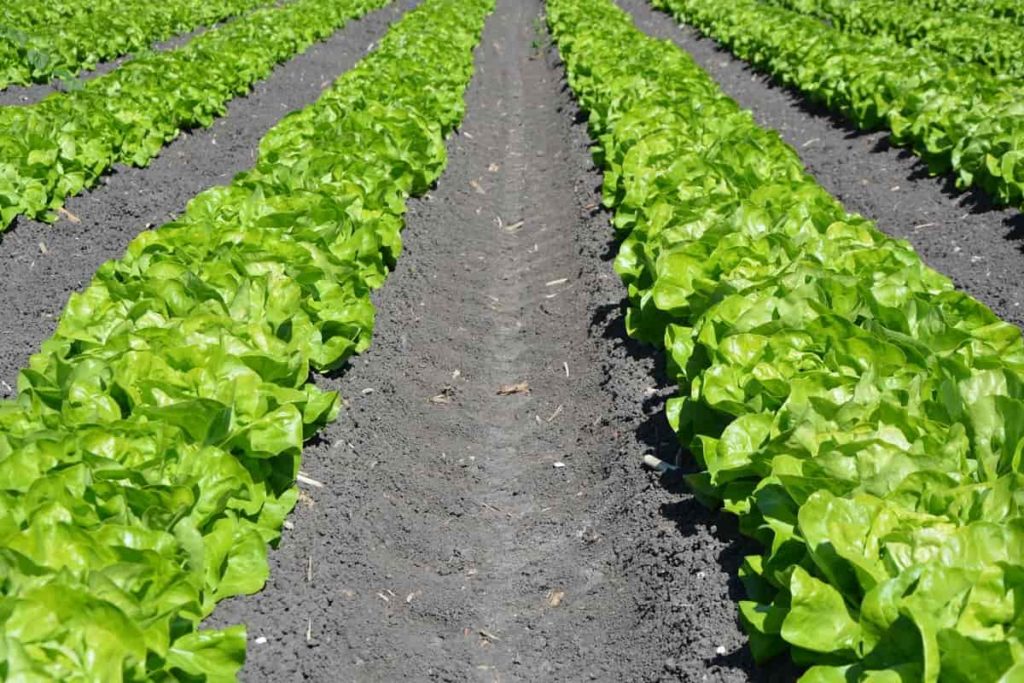
Leaf Lettuce is the most popular variety for home gardens. Lettuce is easy to grow and even easier to grow in containers. It’s much cheaper to grow your Lettuce than to buy Lettuce from shops, and you can grow a variety of Lettuce than you buy from the store. Growing a few varieties will give you all the ingredients you need for a delicious, colorful salad.
Growing Lettuce from seed to harvest
How long do Lettuce take to grow from seed to harvest?
- Lettuce is one of the easiest and more attractive edible plants to grow in vegetable patches.
- You can harvest most Lettuce varieties between 30 and 70 days after planting. When to harvest Lettuce depends on the variety and for whom it will be used. But you can cut looseleaf and butterhead leaves at any time in their development. Heading types take so much time to mature. Romaine Lettuce takes 75 to 85 days, and Crisphead Lettuce takes 70 to 100 days. Indeed, time is based on individual preference. Once your Lettuce reaches the size you want, it’s ready.
- Lettuce grows quite fast. Leaf varieties reach maturity in 30 days but can be harvested as soon as they get the desired size. You can start harvesting leaf varieties much sooner, as they don’t need to reach full maturity first. However, larger varieties, or those that produce heads, require more time to mature.
Can Lettuce be grown from seed?
- This famous salad green is one of the easiest crops to grow in garden beds and containers and is ideal for spring and autumn harvesting. In addition, it is a speedy crop in which baby greens are ready to pick in a month and full-heads about in two months or less.
- The paper plate method is for you if you only have a few Lettuce heads to save seeds. Clip the Lettuce head with a stalk, and rub the ends of dry flowers between your fingers on a paper plate. The seeds will come out perfectly and fall onto the paper plate.
- You can grow Lettuce by sowing seeds. This method allows you to choose from different seeds. Yield from the plant is guaranteed as long as you take good care of it.
- Use good potting soil from your garden supplier in your tray or pot, not soil from your back yard, and gently water them after sowing. Keep them moist but do not keep them wet, and they will emerge in about seven days.
How do you harvest Lettuce without killing the plant?
- Depending on the varieties, you’ll know when to harvest Lettuce leaves when they’re about 3 to 6 inches long. After that, lettuce plants continue to harvest leaves until they bolt. This means that the plant has turned its energy towards producing flowers and seeds, and the leaves usually become bitter tasting with hard stems.
- You can allow the Lettuce plant to mature until it forms a full head of leaves. If you choose this method, cut the entire head of the Lettuce with a knife towards the bottom of the plant or above the soil line.
- To harvest individual leaves, use scissors, garden shears, or a pair of sharp knives to cut large outer leaves near the base of the plant on the stem. Maintain the primary leaves, and the whole Lettuce plant will continue to grow.
- You should cut the plant at the base of its stem and make sure you cut the leaves at least an inch above the soil without damaging the roots.
In case you missed it: How to Prepare the Soil for Lettuce Plants: Best Soil Mix, pH, and Compost

Will Lettuce grow back after cutting?
- The head Lettuce will die back, but most leaf Lettuce plants renew their efforts to produce leaves if regularly trimmed after water. The results will often be smaller than the original plant, but you may be able to harvest a second, good-tasting crop within two weeks.
- Lettuce grows again once its leaves have been cut or picked from the main stem. As long as the root is retained in the ground and has at least 1 to 2 inches of stem and leaves at its base, Lettuce will shoot new growth in as little as a week.
Does Lettuce need full sun?
- Among vegetables, leafy vegetables are the most tolerant of shade, including Lettuce.
- Although Lettuce grows rapidly throughout the sun, it is one of the few vegetables that tolerates some shade. As a result, you can grow a lot of Lettuce in a small space, even in a container.
- Most varieties of Lettuce enjoy full sunlight. You should plant your Lettuce in an area that receives daily about 6 to 8 hours of direct sunlight. Some Lettuce varieties can grow in an area that receives 4 to 6 hours a day.
- Lettuce can withstand light freezing and even one or two harsh freezes, but plants are at risk once at -3°C or below.
- Lettuce grows best in the temperature range of around 8°C to 23°C. In the hotter weather, the leaves become bitter according to taste. When leaf Lettuce bolts, which means they start sending its flower shoots, it indicates that edible Lettuce is done for the season.
How many Lettuce seeds are in a hole?
- How many Lettuce seeds to plant per hole depends on their age. If they are new, apply one per hole. Otherwise, if they are over two years old, apply 2 to 3 per hole, then thin them later if necessary.
- Sprinkle the seeds over the garden soil or indoor tray, or plant them no deeper than ¼ inch. Use the lowest setting on your garden hose outside, or water the indoor tray from the bottom.
- Determine how many seeds to plant outside, and sow the seeds in rows 12 to 18 inches apart.
- If the seed is sown too deep, the seedlings have to fight more soil before they can feel sunlight on their leaves. It may run out of steam before the surface breaks, or once it does emerge, it may be weakened, and a poor early start to growth is hard to recover from.
What happens if you plant Lettuce too close together?
- You should perform a germination test on the seedlings to see which percentage of seeds sprout. Usually, if you plant multiple seeds in a hole, you will have to cut, kill or transplant a secondary plant if both plants grow.
- You should have space plants at a sufficient distance to grow to full size. However, many gardeners plant the Lettuce very close to each other, preferring to harvest the leaves continuously before reaching full size. Plants adapt according to their distance.
- Lettuce takes up very little space and may be edible within a week of planting. However, overcrowding Lettuce or planting it in low-light areas can reduce your crop yield.
How often should Lettuce be watered?
- The roots of Lettuce are shallow, so plants need consistent water. Check and water at least twice a week if the soil dries up to 1 inch deep. Lettuce containers must be watered more frequently than garden beds, especially in the summer.
- Place your Lettuce seeds under the soil. The soil covering the seeds should not be dense. Water more and more every other day. You can easily water Lettuce plants twice a week when sprouting to increase the chances of healthy plants.
- Water your Lettuce plants daily and even more often if it’s extremely hot and dry. Lettuce leaves are mostly comprised of water and will wilt in bright sunlight and dry soil. The roots of Lettuce are shallow, so repeated watering is more important than deep water.
- Too much or too little water can cause disaster for Lettuce plants at every stage of development.
- An indicator of giving more water to your Lettuce plant is to brown the leaves. If the leaves are brown and wilt, and the soil is wet, you will likely get more water. However, brown leaves can also be a sign of underwatering, so check the soil before adding more water.
- Giving too much water to Lettuce plants causes the root to rot and discoloration. Avoid watering during the rainy season.
What is the easiest type of Lettuce to grow?
- Leaf Lettuce types are the easiest Lettuce to grow. Although many people assume that red leaf Lettuce is grown differently, growing red leaf Lettuce is the same as growing green.
- Romaine Lettuce is also one of the most popular varieties of Lettuce and is very easy to grow. You can grow Romaine as a baby crop, harvest young leaves for weeks, or allow plants to mature to full-size heads.
- When grown from seeds, Romaine Lettuce usually takes about three months to fully mature. You can tell that your Lettuce matures when it looks dark green and the leaves look open; the leaves should also overlap into a tight bunch.
In case you missed it: 16 Common Lettuce Plant Problems: How to Fix Them, Solutions, and Treatment
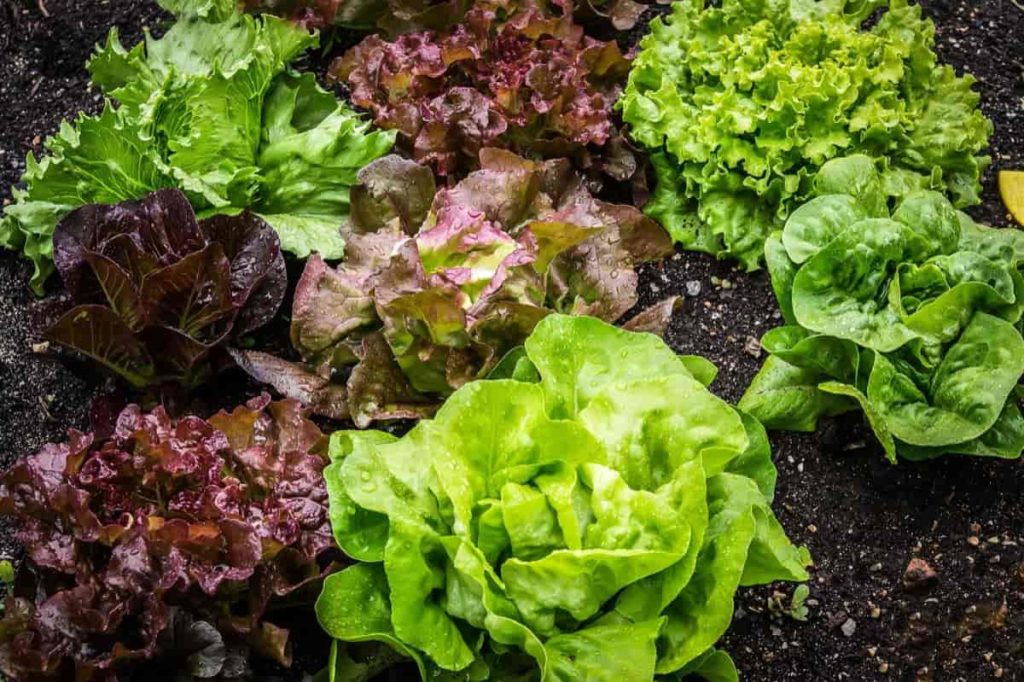
Why is my Lettuce growing so tall?
- Lettuce plants suddenly start stretching towards the sky and are likely to grow extra tall. In the bolting stage, the lettuce plant stops focusing too much on leaf production and begins to turn its attention to reproduction, sending a flower stalk that will eventually dry up to leave the seed.
- Most gardeners believe that bitter Lettuce results from summer heat; When the temperature rises, the plant snaps the maturity mode and bolts, sending a stalk and flowers. It is during this process that bitter Lettuce is produced.
- Most varieties of Lettuce are cold weather crops. When the hot weather arrives, they send long stalks that will flower and set seeds. You will notice that the leaves taste bitter only when the stalks are long. This is called bolting.
What does it mean when Lettuce bolts?
- Bolting in Lettuce occurs when the plant matures and reaches the end of its life cycle. This growth pattern also occurs with many other cold-season plants, including Cilantro, Spinach, and Broccoli. When a plant bolts, it’s just doing what comes naturally.
- The center of the plant starts to elongate as soon as the flower stalk is formed. Another obvious indication is that bitter bites replace the first sweet taste. Sometimes, if you catch a plant in the very early stages of bolting, you can temporarily reverse the bolting process by cutting flowers and flower buds.
How much Lettuce can you get from one plant?
- Before your romaine plant reaches maturity, you can harvest your Lettuce by removing the outer leaves so that the leaves in the center continue to grow. Alternatively, you can dig up the entire plant or cut the plant about an inch above the soil surface, depending on how much Lettuce you want.
- Keep an eye on the romaine head inner leaves and give them time to keep growing. Once they open and mature, they are ready for harvesting. This process can be fast, so check your garden every day. You can get 3 to 4 additional crops by picking mature, external leaves each time. After 10 to 14 days from harvesting, your Lettuce will regrow.
- You can grow leaf Lettuce in rows for good bundles of looseleaf Lettuce, or you can sow it thickly for the crop as young, tender Lettuce in a garden bed or container. By harvesting leaf Lettuce by trimming a few inches above the soil, you can get three to four crops from one plant.
Will Lettuce grow in pots?
- Almost all types of Lettuce grow well in pots. Since their shallow roots do not require deep soil, they excel in wide and shallow containers. Proper drainage holes should be at least 6 to 8 inches deep under the pot. You can use any material for pot, such as plastic, clay, or terracotta pots.
- Lettuce needs plenty of space for roots, but you can grow several varieties in 6 to 12-inch pots. Greens need a constant moisture supply as they are about 95 percent water but cannot tolerate wet roots.
- Lettuce is a fast and easy crop that won’t last forever, so there’s no need for a very deep container or garden bed. A bag of potting soil provides enough growing space for this crop.
Can you fix leggy Lettuce seedlings?
- At the most basic level, leggy seedlings are caused by a lack of light. It could be that the window in which you’re growing your seedlings doesn’t provide enough light, or it could be that the lights you’re using as they grow aren’t close enough to the seedlings. Either way, the seedlings will be leggy.
- You can fix leggy Lettuce seedlings by gently brushing your fingers back and forth along the tops of the plant each day. This simple movement imitates an external wind and tricks the seedlings into thinking they need to grow thick stems to hold them against windy conditions.
Should I cover my Lettuce plants?
- You’ll find that Lettuce has succumbed when you see blisters and tan, dead splotches on the outer leaves. There is no need to come back from such frozen damage. But you may be able to prevent it until the temperature is consistently below -5°C.
- Lettuce is short-lived and tolerant of cold temperatures, although growth will slow down. You should plant Romaine or Butterhead Lettuce, which is the most cold-tolerant, to protect Lettuce in frost-prone areas. You can cover the garden with sheets or towels to provide some protection when frost is predicted.
In case you missed it: Top 14 Lettuce Companion Plants, Planting Guide
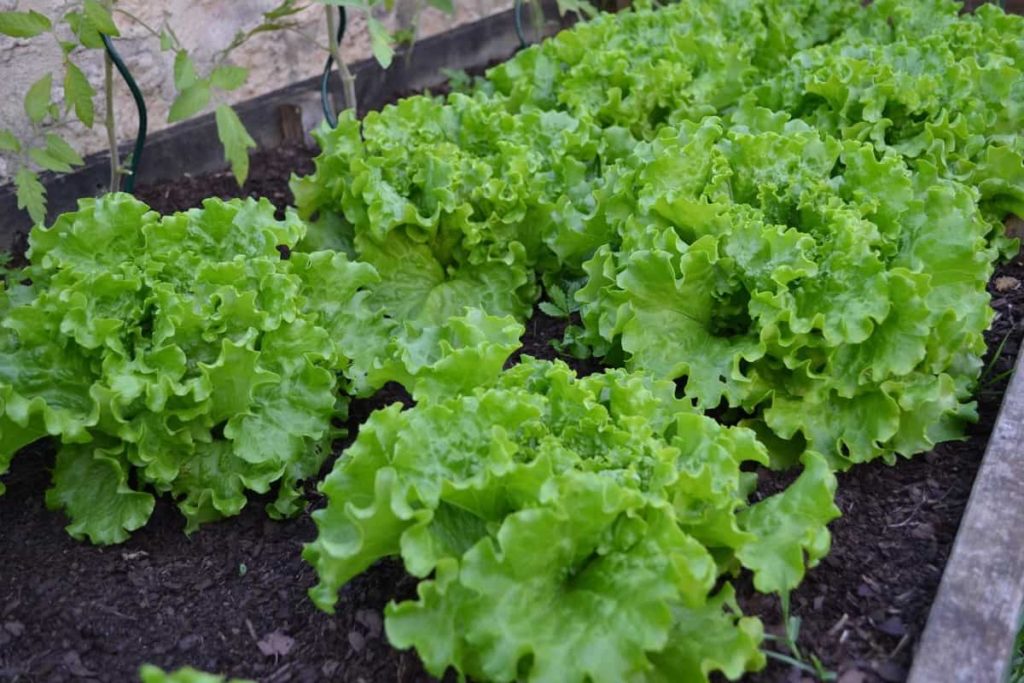
How do you fertilize Lettuce?
- Every two weeks, as often as fertilizer is applied, liquid fertilizer from the water can or in grains scattered around the plants and water. Fertilizer helps thicken the leaves and chase bitterness, often found in garden-grown Lettuce. And that helps keep growing.
- Lettuce requires rich, fertile soil that holds moisture, so it works in much well-rotted organic matter in advance. To prepare for sowing or planting, remove any weeds, fork the ground, then sprinkle with pelleted chicken manure and common-purpose fertilizers like blood, fish, and bone.
- Since Lettuce is a cut-and-come-back crop, they need enough fertilizer to help them keep producing new leaves for the next crop. You should feed Lettuce plants every two weeks with a balanced water-soluble or granular fertilizer, such as 10-10-10 or 5-5-5, diluted to half a strength. Any balanced, all-purpose fertilizer will be sufficient for Lettuce, and anyone with more nitrogen will promote faster, more green growth.
- To apply granular fertilizer to your Lettuce patch, scatter the grains on the ground around your plants at about half the manufacturer’s recommended rate. Most fertilizer is applied at 680 grams per 100 square feet, so you should use it at 340 grams per 100 square feet.
When should I start Lettuce seeds indoors?
- Lettuce seed’s ideal germination and growing temperature are between 16°C and to 18°C.
- When to sow Lettuce seeds depends on when you want the summer/autumn harvest; you can sow out from late March to late July. Sow Lettuce seeds indoors in seed trays in early February for an even earlier harvest and plant under cloches or plastic tunnels in early March.
- You can grow Lettuce during the summer without bolting with some knowledge and a little preparation. You can start replanting Lettuce about 6 to 8 weeks before your first frost. Fall-planted Lettuce can remain unprotected in your garden until early December, depending on where you live. You will plant these indoors in your seed starter in June and move them out in August.
- You should sow seeds in the ground 2 to 4 weeks before your last spring frost date or as soon as work can be done on the ground. Or, to head start, start seeding indoors about one month before your last spring frost date. Harden the seedlings for three days to a week before setting them outdoors.
- Start Lettuce indoors four weeks before transplantation; sow or transplant Lettuce in the garden as soon as the soil can be worked on. Seeds grow at or near 21°C for 2 to 10 days, but sometimes it can take up to 2 weeks for the seed to grow if the soil is cold.
In case you missed it: Lettuce Planting Questions and Answers (FAQs)
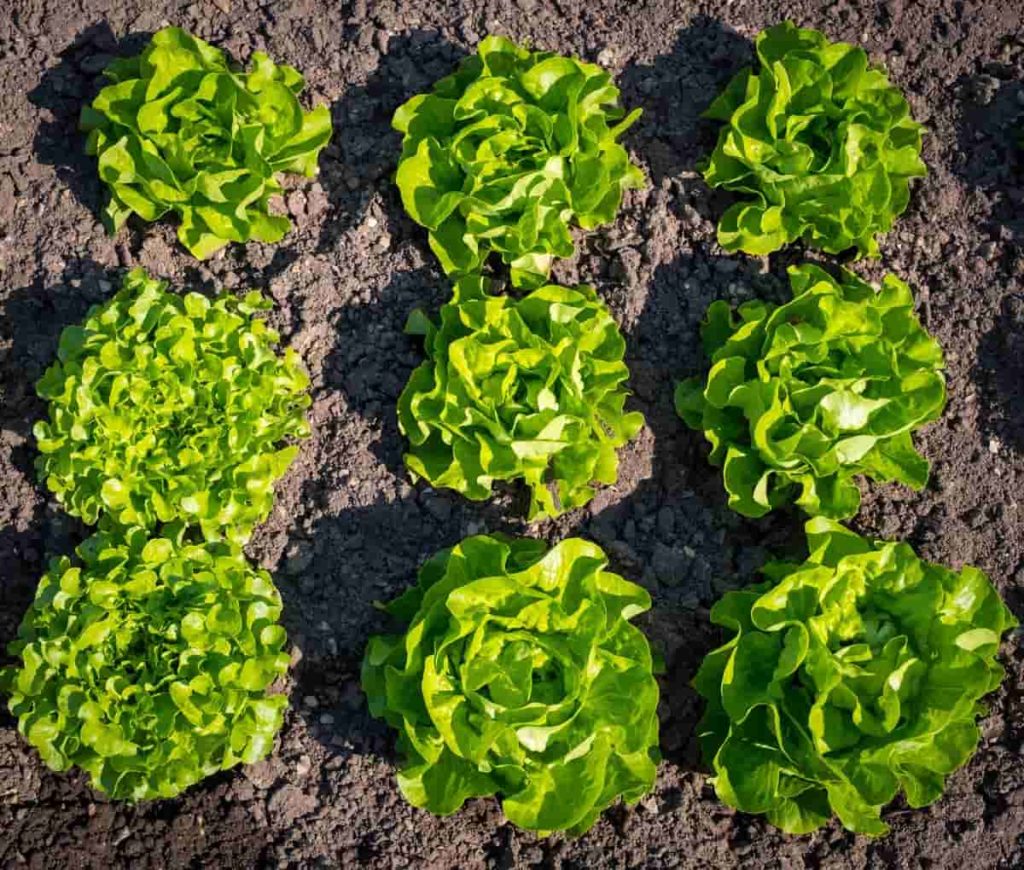
What is the best mulch for Lettuce?
- Lettuce takes advantage of a good layer of mulch like anything else in the garden. Install two- to three-inch layers of organic mulch, such as wood chips, straw, leaves, or grass clippings around the Lettuce, making sure to leave a little space around the plant to prevent rot.
- Dried grass clippings make a perfect organic mulch for Lettuce, as do fertilizers, leaves, and straw. However, don’t let the mulch touch Lettuce leaves, especially if any are wet. Mulch can stick to the leaves and cause problems for removal later.
Can you grow Lettuce indoors?
- Lettuce is quite a simple indoor crop to grow and care for, so there is also the need to grow Lettuce indoors. There are several ways to do this, either hydroponically or from seeds in a pot.
- You can grow Lettuce indoors all winter long. Depending on the available sunlight, even urban gardeners can increase a steady supply of your favorite greens on windows or under lights.
- When growing Lettuce indoors, do not put Lettuce close together. Planting Lettuce seeds that will make heads together prevents proper nutrient use. Instead, provide enough space between each heading of Lettuce. It can be a pot per plant or a location with at least six inches of room between plants.
- In about three to four weeks, the indoor baby Lettuce should be about 4 inches long and ready for harvesting. Because Lettuce is perishable, just cut what you need. You should start with the outer leaves first, trim each leaf at the base of the plant, about an inch from the soil.
How many seeds does a Lettuce plant produce?
- Once the pappuses emerge, but before they complete their seed dispersal, a gardener can only catch the pappuses to collect seeds from each mature head. Each composite Lettuce flower should produce about 15 to 25 seeds, which will make it an easy and quick way to collect enough seeds for home use.
What can you not plant with Lettuce?
- Try to avoid growing Lettuce near Broccoli, Brussels Sprouts, Cauliflower, Cabbage, Kale, or Kohlrabi, while some varieties of Lettuce can help grow these cabbage families (brassica) crops, these plants have special root secretions that can prevent Lettuce seeds from sprouting.
- Fennel is a garden crop that doesn’t play well with most other vegetable garden plants, so it’s not recommended for most home gardeners. While it can attract beneficial insects, it can act as an inhibitor for the growth of most other plants stunting them or even killing them completely.
What companion plants go with Lettuce?
- Seasonally, the great companions of growing with Lettuce include root crops such as Radish, Carrot, Parsnips, or Beets. Taller varieties of flowers or vegetables are the best options, as well as aromatic herbs and allium.
- If you’re wondering what Lettuce can grow with, try some herbs. Basil helps improve the taste of crops like Lettuce and Tomatoes, making it an all-star plant companion combo.
- Lettuce is good with Strawberries, radishes, Carrots as a companion plant, and Cucumbers.
What soil does Lettuce like?
- Lettuce works best in loose, well-drained soil, with regular water and adequate nitrogen. Adding compost will often improve growing conditions, whether your soil is heavy or light sandy.
- Lettuce grows best in loose, cold soil with good drainage. Adding compost or manure will increase drainage, provide essential nutrients, and improve the growing conditions of your Lettuce.
- The horizontal roots branch out of the taproot when the taproot moves downwards. Lettuce planted in compacted soil can expect to reach about 6 inches of root structure, while Lettuce grown in loose soil can produce roots up to 21 inches.
- Lettuce has a fairly short root system and requires only about 6 inches of soil. Choosing a shallow, long pot will give you more surface area, which means more growing plants.
In case you missed it: Growing Organic Lettuce – A Full Guide
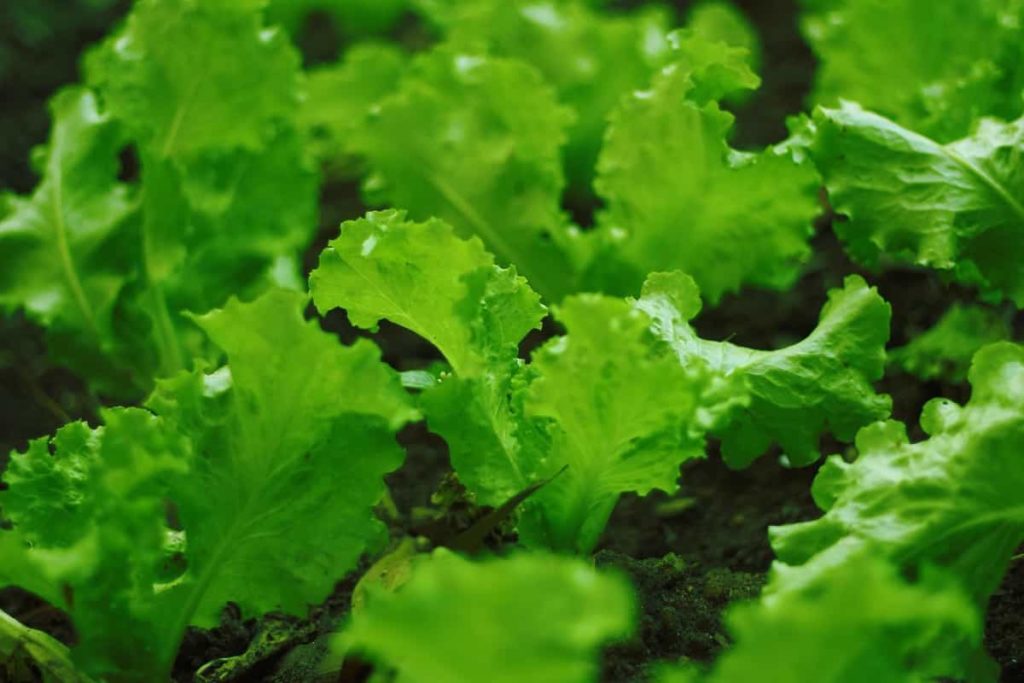
Should you soak Lettuce seeds before planting?
- You can soak your Lettuce seeds before planting to encourage faster growth. You should place Lettuce seeds in clean water and let them sit for a day or more before planting.
- This approach has increased the germination rate by up to 97% when planted in hot conditions. Soaking for less than 16 hours does not positively affect germination.
- However, this is unnecessary; Lettuce seeds should grow well as long as the growing source is moist and hot.
Conclusion
Lettuce is an easy plant to grow almost all year round. It can be grown in pots, window containers, and open ground; and is usually happy at close distances. Some varieties are also enough to go in an ornamental garden.
- How to Grow Hibiscus from Flower
- Plantation Ideas for Home Decoration: A Beginners Guide
- Flower Garden Designs and Layouts for Beginners
- Planting and Spacing Techniques in Papaya: A Beginner’s Guide
- Growing Gold: Essential Techniques for Planting Pineapples
- How to Make Kalanchoe Plant Bushy: Home Remedies and Solutions
- 11 Reasons Why Your Gardenia is Not Blooming: Home Remedies and Solutions
- Eco Elegance: The Guide to Designing a Drought-Tolerant Landscape
- Gardening on a Slope: Strategies for Hillside Landscaping
- Nourish and Flourish: Top Organic Mulches for Thriving House Plants
- Everything You Want to Know about Indian Mogra Flower: Discover Uses and Growing
- Green Thumb Success: Expert Tips for Cultivating Greenhouse Pumpkins All Year Round
- Maximize Growth & Flavor: The Ultimate Guide to Companion Planting in Herb Gardens
- How to Control Rhododendron Problems Naturally: Home Remedies and Organic Ways to Fix Them
- Natural Magic: The Remarkable Benefits of Cinnamon for Plants
- Best Steps to Revive Dying Tulip with Natural and Organic Treatment
- 10 Reasons Why Your Angel Trumpet is Not Blooming: Remedies and Treatment
- How to Fix Periwinkle Leaf and Flower-Related Problems: Natural Remedies and Solutions
- How to Fix Zinnias Leaf and Flower Problems: Discover Natural and Home Remedies
- Organic Steps to Induce Lemon Tree Flowers: A Comprehensive Guide
- Bloom Booster: Crafting the Perfect Homemade Bougainvillea Fertilizer
- Optimizing Growth: A Guide to Applying NPK Fertilizer for Potted Plants
- 10 Best Homemade Fertilizers for Rubber Plant: DIY Recipes and Application Method
- How to Boost Female Pumpkin Flowers: Effective Steps for More Flowers and High Yields
- Transform Your Indoor Garden: Top Benefits of Pink Salt for Houseplants
- 10 Best Homemade Fertilizers for Peacock Plants (Calathea): Easy DIY Guide
- Unlock Blooms: 9 Reasons Why Your Potted Chrysanthemum is Not Blooming
- 8 Reasons Why Your Potted Hibiscus is Not Blooming: Fix it with Simple Solutions
- Unlock Blooms: 9 Key Reasons Your Potted Frangipani Won’t Flower
- 10 Reasons Why Is My Ice Plant Not Blooming: Remedies and Treatment
- 10 Reasons Why My Potted Hydrangea Not Blooming: Treatment and Remedies
- 10 Reasons Why is My Wisteria Not Blooming: Remedies and Treatment
- 10 Reasons Why is My Goldfish Plant Not Blooming: Remedies and Treatment
- Maximize Your Space: Ultimate Guide to Balcony Gardening with Grow Bags
- 10 Reasons Why Your Iris is Not Blooming: Remedies and Treatment
- 10 Reasons Why Your Anthurium Plant is Not Blooming: Treatment and Remedies